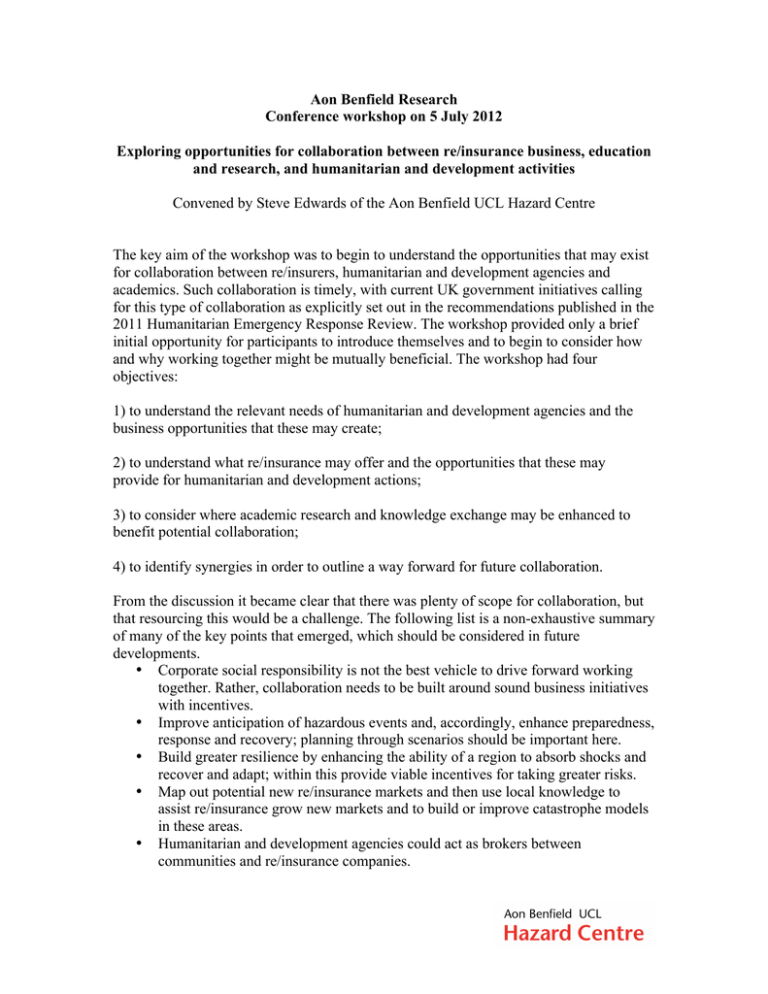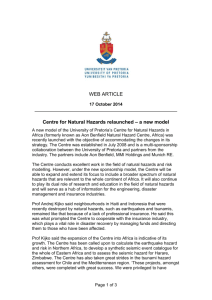Aon Benfield Research Conference workshop on 5 July 2012
advertisement

Aon Benfield Research Conference workshop on 5 July 2012 Exploring opportunities for collaboration between re/insurance business, education and research, and humanitarian and development activities Convened by Steve Edwards of the Aon Benfield UCL Hazard Centre The key aim of the workshop was to begin to understand the opportunities that may exist for collaboration between re/insurers, humanitarian and development agencies and academics. Such collaboration is timely, with current UK government initiatives calling for this type of collaboration as explicitly set out in the recommendations published in the 2011 Humanitarian Emergency Response Review. The workshop provided only a brief initial opportunity for participants to introduce themselves and to begin to consider how and why working together might be mutually beneficial. The workshop had four objectives: 1) to understand the relevant needs of humanitarian and development agencies and the business opportunities that these may create; 2) to understand what re/insurance may offer and the opportunities that these may provide for humanitarian and development actions; 3) to consider where academic research and knowledge exchange may be enhanced to benefit potential collaboration; 4) to identify synergies in order to outline a way forward for future collaboration. From the discussion it became clear that there was plenty of scope for collaboration, but that resourcing this would be a challenge. The following list is a non-exhaustive summary of many of the key points that emerged, which should be considered in future developments. • Corporate social responsibility is not the best vehicle to drive forward working together. Rather, collaboration needs to be built around sound business initiatives with incentives. • Improve anticipation of hazardous events and, accordingly, enhance preparedness, response and recovery; planning through scenarios should be important here. • Build greater resilience by enhancing the ability of a region to absorb shocks and recover and adapt; within this provide viable incentives for taking greater risks. • Map out potential new re/insurance markets and then use local knowledge to assist re/insurance grow new markets and to build or improve catastrophe models in these areas. • Humanitarian and development agencies could act as brokers between communities and re/insurance companies. • • • • • There is a great deal of existing knowledge and a number of existing tools that could be utilised now as long as appropriate resources are available. Quick wins should be investigated to demonstrate that collaboration is worthwhile and beneficial. Existing risk-mapping tools have obvious applications here. Need to look at existing data for areas of mutual interest, with the aim of uploading this into risk assessment tools that exist. Focus should be regional, rather than at local and community level. Development banks will be interested at this large scale and can promote access to the business market. Greater education and training in disaster preparedness and response needed at many levels, up to national government and international organisations. Research and knowledge exchange could be the media to initiate collaboration. In a summary, Dickie Whitaker presented some specific ideas, which he has kindly supplied and these are presented below. 1. Creating maximum benefit for developing countries and insurance It is generally accepted that greatest benefit will accrue where there is a win–win situation. The greatest impact on developing countries can occur when insurance schemes are established. These are considered by the World Bank to be one of the most effective ways to get aid quickly to disaster zones. In addition, brokers view these schemes as giving them a good foothold into developing countries and providing risk transfer mechanisms for acceptable fees. It was mentioned by Aon Benfield's CEO that this was an area for future growth. Suggested action: Develop databases of territories that the development banks are looking to work with and have joint meetings with Aon Benfield and relevant aid agencies and academic partners to provide coordinated action plans. 2. Partnerships These are recognised as being of key importance in creating success in this demanding area. The distillation of possible partners and networks is, however, complex as they vary in every situation. Suggested action: Develop lists of networks and partners that can offer practical benefits in general and can form part of every new combined project activity. These should include government agencies, research networks, aid agencies and quangos, in addition to insurance and finance organisations. 3. Micro-insurance This has the potential to provide effective benefit in the poorest countries. Its practical benefits are, however, not widely known and shared, but the mainstream insurance industry is keen to offer support and ideas. It is believed that efforts in this area are fragmented and would benefit from additional research and collaboration. Suggested action: Produce an inventory of schemes, literature and research in this area and propose and review opportunities for broader dissemination of best practice and identification of gaps in knowledge that need additional innovation and/or research. 4. Funding opportunities Many gaps in knowledge exist that require academic research to fill these and to stimulate innovation. Funding for these can come from a number of sources, which include industry, think tanks and UK research councils. Some specific schemes also exist for certain sectors and the most practical have a co-funding component. These include schemes with the Economic and Social Research Council, the Engineering and Physical Sciences Research Council, the Natural Environment Research Council, the Technology Strategy Board and the Lighthill Risk Network. Suggested action: Send opportunities, suggestions or questions to dickie.whitaker@fs-net.org. 5. Dissemination of models, datasets and maps There is much environmental information that could be disseminated usefully to both the developing and developed world. Some charities exist to provide GIS information, for example. However, more complex models have historically lacked a simple vehicle to allow dissemination. Aon Benfield's Elements and a new not-for-profit company called Oasis, which is partly owned by Aon Benfield, could be used. Oasis, when completed, will be used for free. Suggested action: Further information available from http://oasislmf.org/ or Dickie Whitaker. 6. Collaboration Historically there has been little collaboration between humanitarian and development organisations and the insurance sector and this should now be addressed. Suggested actions: Small focused groups should be used to enhance engagement between the sectors. There may, however, be an opportunity for one event to provide a focus for this collaboration and a suggestion has been made to hold a conference on Christchurch, which should have the following objectives: • To share world leading research and knowledge of disaster mitigation, resilience and response to emerging and developed nations. New Zealand is already a leader here. • To discuss how academia and business can more effectively collaborate on disaster mitigation and risk transfer. The way forward All participants are thanked for their initial interest and are encouraged to remain engaged with this initiative. There is a need to follow-up on the discussions that took place during the workshop. Steve Edwards is happy to take matters forward and initial thoughts and ideas should in the first instance be channelled through him at s.edwards@ucl.ac.uk.










